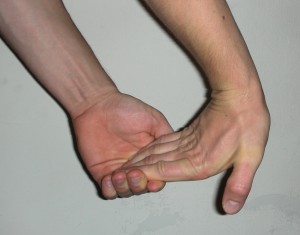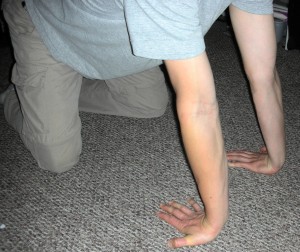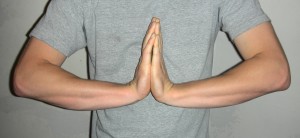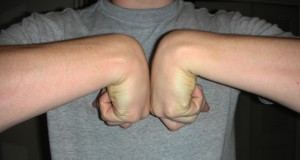This is a report that was found only in the Hand Balancing Mastery Course. But as so many people have these issues (and its something I’ve had to deal with too) I figured I needed to put this article up here for everyone to see.
*****
Before you begin any hand balancing it would be wise to stretch out your wrists. I suffered a injury in my football playing days back in high school to my right wrist. So doing this is almost a necessity for me before I try to hold a handstand because my right wrist is naturally inflexible.
The most basic stretch is to bend your wrist back by using your other hand to push back the fingers toward the backside of the wrist. With this exercise you can stretch out the wrist and fingers. Be sure to do this with both sides.

This stretch can be done in a similar manner by using the floor or a wall. Kneel on the ground with your arms in front of your body and your palms pointing away from you. Place the fingers on the ground and stretch you hands in the same manner as above. Both hands can be done at once.

Another alternative is to place your palms together at about chest level as if you were praying. While keeping the hands flat and together lower them across your body.

All three of these stretches will build the your wrist flexibility in the most important way for hand balancing.
Some people are more flexible than others. As long as you can get your palm bent a little more than 90 degrees back from the wrist you are set to do a normal handstand. If you cannot reach this position then your flexibility must be improved.
Here are the steps you need to do that.
Assume the normal pushup position with you hands flat on the ground pointing forward. With added weight on your hands from your body it becomes easier to stretch further. While keeping your body straight, try leaning forward and back, solely focusing on improving the flexibility of your wrists.
For some people this causes too much strain on the wrists. If there is pain then you must work on a progressive approach to build up the strength of your wrists. If the pushup position is too much for you to bear then simply lean against a wall. With your wrists bent back as far as you can, push into to wall until your hands are slightly uncomfortable. You should do this exercise throughout the day everyday and gradually lower your body until you reach the ground. At that point raise your feet up until you can hold a handstand without problems.
If you are stuck at this point were handstands cause your wrist pain, you can still hand balance but in a different way. Just like people with problems will do pushups with there fists on the ground, you can do the same.
Understand that doing even a normal handstands with your fists on the ground, rather than your flat hands, is much more difficult. Simply because you base for balancing is smaller.
Instead of working the flexion and extension muscles of the forearm you will be working those that control deviation. Deviation is the act of changing the angle of the wrist joint in the direction of the pinkie finger or thumb.
Radial deviation involves moving the hand toward the thumb side. Ulnar deviation involves moving the hand toward the pinkie finger side.
The muscles, tendons and ligaments that control deviation tend to be weaker than those that control flexion. This on top of the smaller base.
In addition to going fists on the floor, any parallel bars or pushup handles can be used the same way. Being able to grip these apparatuses will help to keep you up.
While you can do all these moves (and you should practice them with or without wrist problems) it is important to build the strength and flexibility of your hands at the same time. This allows you to work on your hand balancing while building up your ability to go with hands flat on the ground.
Some people have very flexible wrists. This will help out with some more advanced stunts such as the planche or various press-ups. However it is not necessary as you can turn your hands outward to reduce the strain. That being said it is always helpful to improve your flexibility. Use the stretches above and add more force in order to improve your flexibility. Tensing the muscles in your forearm by pushing into the ground with your fingers followed by relaxing them will build the needed strength together with flexibility.
Hand balancing of all sorts will give you strong forearms. One of the main functions of the forearm is flexion of the hand. This is when the hand is brought toward the inside of your forearm. While handbalancing does not give you a full range of motion in this, it will make these muscles stronger simply from the strength it takes to press your fingers into the ground to keep your body aloft. In any handstand your wrists are extended but you will be working the flexion muscles primarily.
Should you ever develop any pain in your arms from practicing hand balancing then it is likely that your have pushed too hard too fast. Back off for a bit then ease into it to see if the pain goes away. If the problem persists then see your doctor. You should get to a point where hand balancing does not cause any pain or discomfort in your hands or arms.
Many of the odd hand positions found in Handbalancing Made Easy will take your wrist flexibility to a new level. Do the ones you can while working up to the ones you cannot do currently and you will find your hands become stronger and more flexible.
After your training it is good to even out the stretch. To do this put your hands in front of your chest and place the backs of the hands against each other. Kind of the opposite of the prayer stretch above. While keeping the backs of the hand firmly pressed together attempt to bring your elbows downward. You will not get very far but the point is to get a stretch with your wrists fully flexed as opposed to completely extended.


Comments
I am a break dancer and i was trying to work on 1 handed handstand balance however after a while my right wrist developed a sharp pain on the wrist (the back of the hand side.) i looked online for streches and all i found was an article that said stay off your wrist for about 6 months. any ideas. also if you can thing of any weight training to help me hold the balance would be greatly appreciated.
@John Green: Sometimes you do need to rest. Other times the rest won’t help. I’d work with these stretches here for a time and see if they help. It really depends on the specific injury and its hard to give specific advice on it. There are also some topical solutions they may help.
As far as weight training for balance, Professor Orlick has an exercise call the Dumbbell Wig Wag, where you hold a heavy double overhead and move it around to strengthen the shoulder. Similar to whats needed for one arm balances.
.
Thank you for these stretching exercises and all other awesome articles! I will put them to use now. 🙂
I just built my own hand stands (could not afford to buy them already made), today.